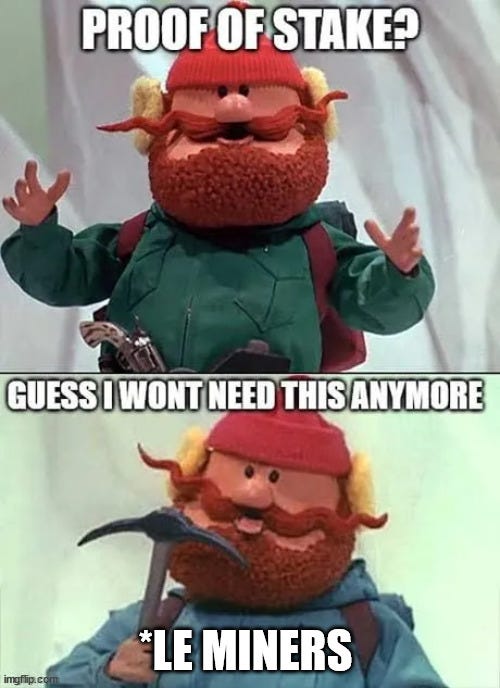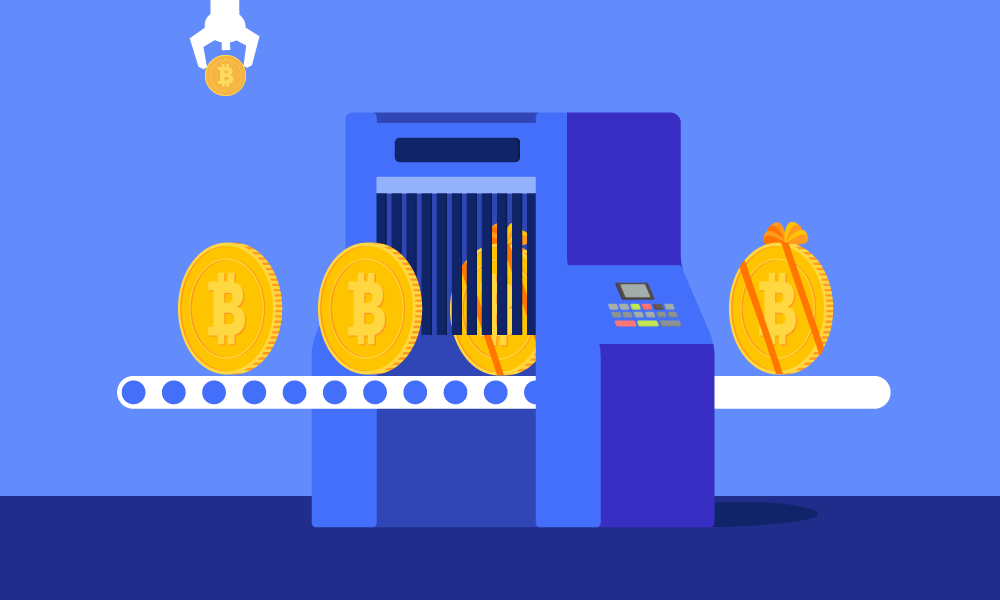Web3 Glossary: V & W of web3
Who are the money minters in web3?
Gm gm folks!
I’d like to ask you a question:
Do you remember the first time you heard about Blockchain?
Maybe you took it as a new technology that would change everything. Maybe you just wondered if you should start investing in crypto.
Maybe you were just getting your head around the concept of a decentralized web
The truth is web3 is indeed the decentralized internet of the future🚀
web3glossary series was started with the idea to help people understand this space better and clear the air around the terms & jargons we hear around. We are almost at the end of the series and I would like to hear from you what value you gained from it and what more would you like to see😃
Until then, let’s see what do we have in store today?
V: Validators
W: WWW, Wrapped token, wei
Validators of blockchain technology aren't only its sower but its rewards reaper too. Let's get to the depth of it🧐
But first, here's some humor to start with 👇👇
What are crypto validators and how do they work?
Crypto validators = Payment processors of the decentralized networks.
Technically, a crypto validator is a participant in a blockchain responsible for verifying transactions.
After verifying the legitimacy of the transaction, the validator adds it to the distributed ledger.
Seems like the job of a blockchain validator is not that difficult!
You receive some data, check its accuracy, and validate it or not. SIMPLE!!
However, on a distributed ledger, it's easier said than done👀👀
The role of a validator may change depending on the consensus mechanism that each blockchain uses.
What differs across consensus mechanism?
Let’s find out🧐
Miners in PoW = Validators in PoS
PoW blockchains require validators to prove they worked on checking data before adding new transactions to the chain. It ensures the integrity of new data as it requires members of the network to expend effort in solving an arbitrary mathematical puzzle to prevent anybody from gaming the system. And hence validators are called Miners
The first miner to successfully validate a new block of data receives a block reward. As of today, that reward is worth 6.25 BTC.🤑
In PoS, users have to stake a specific amount of the ledger’s native token(ETH in case of Ethereum) to become validators. Also, the system selects the staker via lottery, depending on each validator’s percentage of the total staked funds.
An example to make it easier for ya’ll 👇👇
Ethereum 2.0 validators stake 32 ETH (ether) to participate, and in order to increase their chances of winning the reward, they can set up multiple nodes, each with a stake of 32 ETH
But, but
What about chains which don’t use these consensus algos?🤔
They too have validators!
For eg.
Stellar operates on Byzantine Fault Tolerance consensus mechanism.
A decentralized ledger that uses this mechanism can have some nodes providing inaccurate data for validation. These nodes may be corrupt and intentionally misuse the network.
HOWEVER 👀
As long as the majority of the validator nodes are honest, the validation process has an accuracy guarantee. As a result, it adds more data to the chain despite the malicious actions of some of its nodes.
It’s important to note, data can receive validation as long as these spurious messages exceed "one-third" of the total. Otherwise, the transaction would become invalid.
Let's summarise, shall we?👇👇
📌Miners in PoW, don’t stake anything, use high-performance computers to solve mathematical puzzles quickly and efficiently.
📌Miners in PoS, stake crypto assets to become validators. No need for expensive, eco-damaging computers, they can simply buy digital coins.
Want to become a validator?🤑🤑
Checkout this blog to mint some money and support the ecosystem:
https://consensys.net/blog/developers/my-journey-to-becoming-a-validator-on-ethereum-2-0-part-2/
Validator’s role has come a long way from the initial Bitcoin miner and up to the present-day Solana validator.
Blockchain has been both a source of passive and active income and being a validator on a decentralized ledger combines the both 💯
Taking a step back, let’s go back to where it all started- the world wide web👇
Web1 was about communication, Web2 is about interaction, & Web3 is all about ownership.
As Web 3.0 evolves, several game-changing concepts have emerged and gained popularity in recent times like DAOs, NFT and DeFi.
👉 Decentralized Finance(DeFi) deals with Dapps, wallets, protocols on money movement and other standards around the cryptocurrencies and tokens.
The DeFi space has been growing exponentially however, DeFi needs cross-chain liquidity for global adoption.
Wrapped tokens offer a solution.
Wrapped tokens allow users to transact with cryptocurrencies via blockchains or token standards outside their original design scope. They’re usually created by holding the original asset in a digital vault, then issuing a wrapped token representing the vault assets.
They allow for greater interoperability between previously non-compatible digital assets across chains.
Almost every major blockchain has a wrapped version of its native cryptocurrency
Eg: Wrapped ethereum (WETH)
👉 WETH refers to the ERC-20 compatible version of ether.
👉WETH can be created by sending Ether to a smart contract where the Ether is placed on hold, in turn receiving the WETH ERC-20 token at a 1:1 ratio.
👉This WETH can then be sent back into the same smart contract to be unwrapped /redeemed back for the original ether at a 1:1 ratio
But why do we even need wrapped tokens?🤔
ETH, the native cryptocurrency of Ethereum was created before the ERC-20 standard was implemented. Hence Ether itself is not ERC-20 compatible and cannot be exchanged directly for other ERC-20 tokens in a decentralized manner without the mediation of a trusted third party.
So, it solves for low interoperability of blockchains-
Native coins of one chain cannot be used on another chain. And they do so by tokenizing native coins & applying the blockchain’s token standard to the tokenized version of the original cryptocurrency
How does it work?
For instance, with WETH, you could go to any DEX like Uniswap and swap your ETH for WETH. The original ETH is converted to WETH, but the value stays the same, similar to how dollar-pegged stablecoins work.
Technically, a custodian (smart contract, multi sign wallets or a merchant) holds your Ether and give you WETH in return
Checkout this concise infographic by Cointelegraph
Moving on, you know that fiat currency(USD, INR, Euros etc) is divisible only into a finite number of parts. 1 Indian rupee is only divisible into 100 parts, and a Paisa is the atomic unit of the Indian currency.
But digital cryptocurrencies are divisible into much, much smaller units.
That’s where wei comes in
Wei is the smallest denomination of Ether
1 ETH = 1,000,000,000,000,000,000 wei (10^18)
Many of ya’ll wont know this 👀👀
Wei was named after Wei Dai, a cryptography activist who is known for supporting the widespread use of strong cryptography and privacy-oriented technologies
That’s a wrap for today!
Stay tuned for more on the new vocabulary of the web for next 30 days.💯
It’s a free crash course on the jargons and terminologies in Web3 direct to your email
As ever, thank you for subscribing and reading. It matters. It’s a big deal to me.
And, remember, half-true compliments and feedbacks are always welcome at:
laisha.wadh [at] gmail [dot] com
WAGMI 🚀🚀










